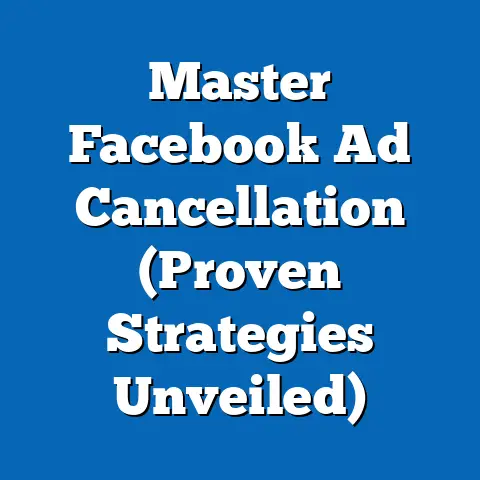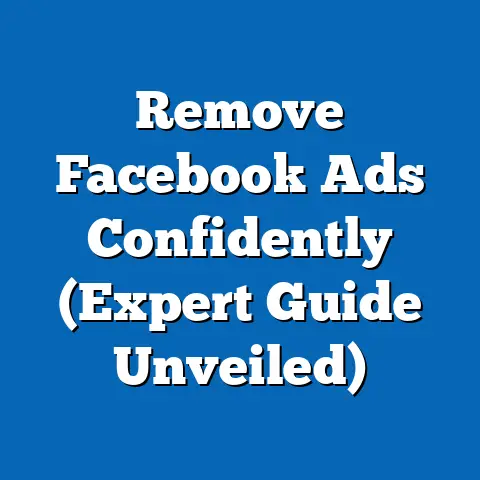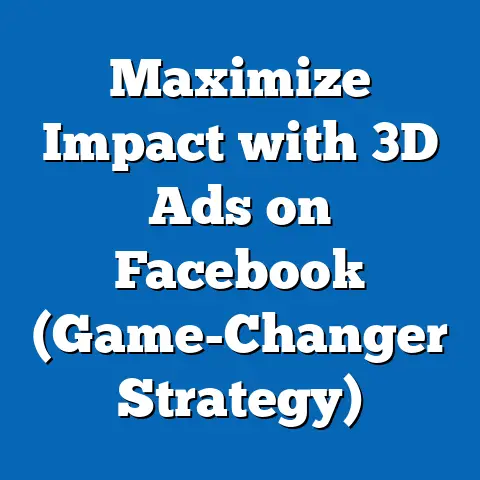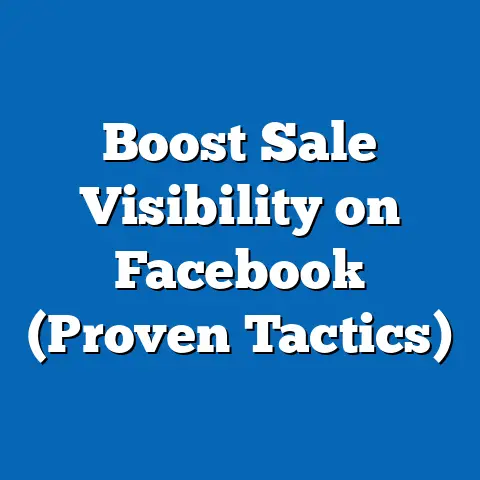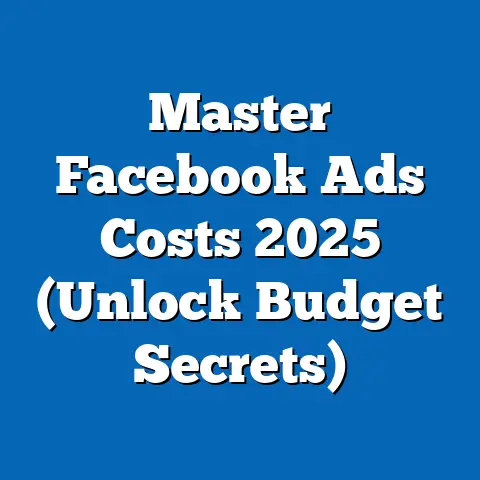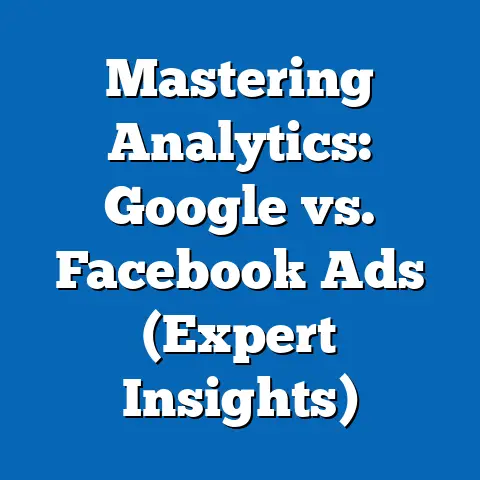Remove Facebook Ads Hassles (Streamlined Strategies)
Facebook has become a powerhouse for businesses seeking to connect with their target audience. I’ve seen firsthand how companies, big and small, leverage Facebook Ads to boost brand awareness, drive sales, and foster customer loyalty. But let’s be honest, navigating the world of Facebook advertising isn’t always a walk in the park. The challenges are real: budget constraints that keep you up at night, fierce competition vying for the same eyeballs, and the sheer complexity of managing campaigns that feel like juggling chainsaws.
One of the biggest hurdles? Affordability. It’s the linchpin of any successful Facebook advertising campaign. If you can’t manage your costs effectively, you’re essentially throwing money into the digital abyss. That’s why I’m diving deep into streamlined strategies that not only alleviate the hassles of Facebook Ads but also keep costs manageable for businesses of all sizes. This isn’t just about saving a few bucks; it’s about maximizing your return on investment and driving sustainable growth. I’ll be sharing insights I’ve picked up over the years, strategies that have helped my clients and me navigate the ever-changing landscape of Facebook advertising. So, let’s get started on removing those Facebook Ads hassles and making your campaigns more affordable and effective.
Understanding Facebook Ads Costs
Let’s break down the financial side of Facebook advertising. It’s crucial to understand where your money is going so you can make informed decisions and optimize your spending. The primary costs associated with Facebook Ads include:
- CPC (Cost Per Click): This is the amount you pay each time someone clicks on your ad. It’s a direct measure of how engaging your ad is and how well it resonates with your target audience.
- CPM (Cost Per Mille): CPM, or Cost Per Thousand Impressions, is the cost you pay for every 1,000 times your ad is displayed. This is useful for measuring brand awareness and reaching a large audience.
- Ad Spend Limits: Setting daily or lifetime budgets for your campaigns is essential. This prevents overspending and allows you to control your overall investment.
Setting a clear budget is paramount. I’ve seen campaigns crash and burn simply because there was no clear budget in place. It’s like driving without a gas gauge; you’re bound to run out of fuel sooner or later. Your budget affects everything, from the reach of your ads to the frequency with which they’re shown.
Now, let’s talk about Return on Ad Spend (ROAS). This is the holy grail of advertising metrics. It measures how much revenue you generate for every dollar you spend on ads. Affordable strategies are all about maximizing ROAS. It’s not just about spending less; it’s about spending smarter. A high ROAS means you’re getting more bang for your buck, and that’s the ultimate goal.
For instance, if you’re running an e-commerce store, setting a realistic budget might involve analyzing your average order value, profit margins, and conversion rates. If your average order value is \$50, and your profit margin is 30%, you need to ensure that your ad spend doesn’t eat into those profits. A good starting point might be to allocate 10-15% of your projected revenue to advertising.
Takeaway: Understand the different costs associated with Facebook Ads, set a clear budget, and focus on maximizing your ROAS. This will help you stay within your financial limits while achieving your advertising goals.
Streamlining Ad Creation
Creating compelling ads is an art and a science. It’s about crafting messages that capture attention, resonate with your audience, and drive action. However, it doesn’t have to break the bank. There are plenty of ways to streamline ad creation without sacrificing quality.
One of the most effective strategies is to leverage free or low-cost tools. Canva, for example, is a fantastic resource for creating visually appealing graphics and videos. Facebook’s own ad creation tools are also surprisingly robust, offering templates and editing features that can help you produce professional-looking ads quickly and easily.
A/B testing is your secret weapon for refining ad content without overspending. By testing different headlines, images, and calls to action, you can identify what works best and optimize your ads for maximum impact. I once ran an A/B test where I simply changed the color of the call-to-action button, and it resulted in a 20% increase in click-through rates. It’s the little things that can make a big difference.
Don’t reinvent the wheel. Reusing ad creatives across different campaigns can save you time and money. If you have a successful ad that’s performing well, consider repurposing it for other campaigns or audiences. Just make sure to tailor the message to the specific context.
Takeaway: Use affordable tools, A/B test your ads, and reuse successful creatives. This will help you create compelling ads without breaking the bank.
Targeting the Right Audience
Targeting the right audience is like aiming a laser beam instead of a floodlight. It’s about focusing your resources on the people who are most likely to be interested in your product or service. Precise audience targeting is crucial for avoiding wasted ad spend. If you’re showing your ads to the wrong people, you’re essentially throwing money down the drain.
Facebook’s Audience Insights is a goldmine of data. It provides valuable information about your target demographics, including their interests, behaviors, and demographics. Use this data to define your ideal customer profile and create highly targeted ad campaigns.
Custom audiences allow you to upload your own customer data, such as email lists or phone numbers, and target those specific individuals on Facebook. Lookalike audiences, on the other hand, allow you to reach new people who are similar to your existing customers. These are both incredibly powerful and affordable ways to expand your reach and connect with potential customers.
Retargeting is another strategy that can significantly lower your acquisition costs. By showing ads to people who have previously interacted with your website or brand, you can re-engage them and drive conversions. I’ve seen retargeting campaigns achieve conversion rates that are 2-3 times higher than standard campaigns.
For instance, a local bakery could use Facebook’s audience insights to identify people who are interested in baking, cooking, or local food. They could then create a custom audience by uploading their email list and target those customers with special offers and promotions. Finally, they could create a lookalike audience to reach new people who are similar to their existing customers.
Takeaway: Use Facebook’s audience insights, custom audiences, lookalike audiences, and retargeting to reach the right people with your ads. This will help you avoid wasted ad spend and maximize your ROI.
Optimizing Ad Performance
Continuous optimization is the name of the game. It’s about constantly monitoring your ad performance, identifying areas for improvement, and making adjustments to your campaigns. This is a vital strategy for reducing costs and improving your overall results.
Tools like Facebook Ads Manager and Google Analytics provide a wealth of data about your ad performance. Track metrics such as click-through rates, conversion rates, and cost per acquisition to understand how your ads are performing.
Analyze the data to make informed decisions about adjusting your bids, ad placements, and targeting. If you notice that a particular ad is underperforming, don’t be afraid to pause it or make changes. Reallocate your budget to successful ads to maximize your ROI.
I once had a client who was running a campaign to promote a new product launch. The initial results were disappointing, with low click-through rates and high cost per acquisition. After analyzing the data, I realized that the ad was being shown to a broad audience that wasn’t particularly interested in the product. I narrowed the targeting to focus on people who had previously purchased similar products or expressed interest in the category. The result was a dramatic improvement in ad performance, with click-through rates increasing by 50% and cost per acquisition decreasing by 30%.
Takeaway: Continuously monitor your ad performance, analyze the data, and make adjustments to your campaigns. This will help you reduce costs and improve your overall results.
Leveraging Automation
Automation is your secret weapon for streamlining Facebook Ads management. It can help you save time, reduce costs, and improve your overall efficiency.
Features like automated rules allow you to set up triggers that automatically adjust your bids, pause ads, or send notifications based on specific performance criteria. Dynamic ads, on the other hand, automatically generate personalized ads based on user data. This can help you create more engaging and relevant ads without having to manually create hundreds of variations.
AI-driven tools are also becoming increasingly popular for ad optimization and audience segmentation. These tools use machine learning algorithms to analyze your data and make recommendations for improving your campaigns. They can help you identify new audiences, optimize your bids, and create more effective ad creatives.
For small businesses, automation can be a game-changer. It allows you to compete effectively without a large budget or a dedicated team of marketing experts. By automating tasks such as bid management and ad creation, you can free up your time to focus on other aspects of your business.
Takeaway: Leverage automation features like automated rules and dynamic ads to streamline your Facebook Ads management. This will help you save time, reduce costs, and improve your overall efficiency.
Conclusion
Affordability is key to successful Facebook advertising. By understanding the costs, streamlining ad creation, targeting the right audience, optimizing ad performance, and leveraging automation, you can remove the hassles associated with running effective campaigns and achieve more efficient, cost-effective results that drive business growth.
Remember, it’s not just about spending less; it’s about spending smarter. By implementing these streamlined strategies, you can maximize your ROI and achieve your advertising goals without breaking the bank. So, go ahead and put these strategies into action. I’m confident that you’ll see a significant improvement in your Facebook advertising results.

